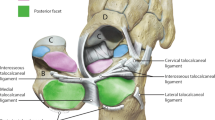Abstract
Objective
Using digitally reconstructed radiographs (DRRs), we determined how changes in the projection angle influenced the assessment of the subtalar joint.
Materials and methods
Weightbearing computed tomography (CT) scans were acquired in 27 healthy individuals. CT scans were segmented and processed to create DRRs of the hindfoot. DRRs were obtained to represent 25 different perspectives to simulate internal rotation of the ankle with and without caudal angulation of the X-ray beam. Subtalar joint morphology was quantified by determining the joint space curvature, subtalar inclination angle (SIA), calcaneal slope (CS), and projection of the subtalar joint line on three-dimensional (3-D) reconstructions of the calcaneus.
Results
The curvature of the projected joint space was altered substantially over the different DRR projections. Simulated caudal angulation of the X-ray beam with respect to the ankle decreased the SIA and CS significantly. Internal rotation also had a significant impact on the SIA and CS if the X-ray beam was in neutral or in 10° of caudal angulation. An antero-posterior (AP) view of the ankle showed the posterior area of the posterior facet, whereas a more anterior area was visible with internal rotation of the foot and caudal angulation of the X-ray beam.
Conclusion
Internal rotation of the foot of 20° is recommended to assess the posterior aspect of the posterior facet, whereas a combined 20° internal rotation of the foot and 40° caudal angulation of the X-ray beam is best to assess the anterior aspect of the posterior facet of the subtalar joint.








Similar content being viewed by others
References
Krähenbühl N, Horn-Lang T, Hintermann B, Knupp M. The subtalar joint: a complex mechanism. EFORT Open Rev. 2017;2(7):309–16.
Cody EA, Williamson ER, Burket JC, Deland JT, Ellis SJ. Correlation of talar anatomy and subtalar joint alignment on weightbearing computed tomography with radiographic flatfoot parameters. Foot Ankle Int. 2016;37(8):874–81.
Wang B, Saltzman CL, Chalayon O, Barg A. Does the subtalar joint compensate for ankle malalignment in end-stage ankle arthritis? Clin Orthop Relat Res. 2015;473(1):318–25.
Lopez-Ben R. Imaging of the subtalar joint. Foot Ankle Clin. 2015;20(2):223–41.
Apostle KL, Coleman NW, Sangeorzan BJ. Subtalar joint axis in patients with symptomatic peritalar subluxation compared to normal controls. Foot Ankle Int. 2014;35(11):1153–8.
Hayashi K, Tanaka Y, Kumai T, Sugimoto K, Takakura Y. Correlation of compensatory alignment of the subtalar joint to the progression of primary osteoarthritis of the ankle. Foot Ankle Int. 2008;29(4):400–6.
Krähenbühl N, Tschuck M, Bolliger L, Hintermann B, Knupp M. Orientation of the subtalar joint: measurement and reliability using weightbearing CT scans. Foot Ankle Int. 2016;37(1):109–14.
Probasco W, Haleem AM, Yu J, Sangeorzan BJ, Deland JT, Ellis SJ. Assessment of coronal plane subtalar joint alignment in peritalar subluxation via weight-bearing multiplanar imaging. Foot Ankle Int. 2015;36(3):302–9.
Rammelt S, Bartonicek J, Park KH. Traumatic injury to the subtalar joint. Foot Ankle Clin. 2018;23(3):353–74.
Colin F, Horn Lang T, Zwicky L, Hintermann B, Knupp M. Subtalar joint configuration on weightbearing CT scan. Foot Ankle Int. 2014;35(10):1057–62.
Krähenbühl N, Siegler L, Deforth M, Zwicky L, Hintermann B, Knupp M. Subtalar joint alignment in ankle osteoarthritis. Foot Ankle Surg. 2019;25(2):143–9..
Van Bergeyk AB, Younger A, Carson B. CT analysis of hindfoot alignment in chronic lateral ankle instability. Foot Ankle Int. 2002;23(1):37–42.
Barg A, Amendola RL, Henninger HB, Kapron AL, Saltzman CL, Anderson AE. Influence of ankle position and radiographic projection angle on measurement of supramalleolar alignment on the anteroposterior and hindfoot alignment views. Foot Ankle Int. 2015;36(11):1352–61.
Guo C, Zhu Y, Hu M, Deng L, Xu X. Reliability of measurements on lateral ankle radiographs. BMC Musculoskelet Disord. 2016;17:297.
Kuo CC, Lu HL, Lu TW, Lin CC, Leardini A, Kuo MY, et al. Effects of positioning on radiographic measurements of ankle morphology: a computerized tomography-based simulation study. Biomed Eng Online. 2013;12:131.
Hallgren KA. Computing inter-rater reliability for observational data: an overview and tutorial. Tutor Quant Methods Psychol. 2012;8(1):23–34.
Yeung TW, Chan CY, Chan WC, Yeung YN, Yuen MK. Can pre-operative axial CT imaging predict syndesmosis instability in patients sustaining ankle fractures? Seven years’ experience in a tertiary trauma center. Skeletal Radiol. 2015;44(6):823–9.
Broden B. Roentgen examination of the subtaloid joint in fractures of the calcaneus. Acta Radiol. 1949;31(1):85–91.
Sarrafian SK. Biomechanics of the subtalar joint complex. Clin Orthop Relat Res. 1993;290:17–26.
Barg A, Bailey T, Richter M, de Cesar Netto C, Lintz F, Burssens A, et al. Weightbearing computed tomography of the foot and ankle: emerging technology topical review. Foot Ankle Int. 2018;39(3):376–86.
Acknowledgments
The authors thank Andrew E. Anderson, PhD, research associate professor at the University of Utah, who provided technical and editorial support.
Funding
This work was supported by a grant from the Swiss Society of Orthopaedic Surgery (Swiss Orthopaedics). It was also supported by the LS Peery Foundation (University of Utah) and by the National Institutes of Health (NIH-R21AR063844). Nicola Krähenbühl received a grant from the Swiss National Science Foundation (SNF; grant number P2BSP3_174979).
Author information
Authors and Affiliations
Corresponding author
Ethics declarations
Ethical approval
All procedures performed in studies involving human participants were in accordance with the ethical standards of the institutional and/or national research committee and with the 1964 Declaration of Helsinki and its later amendments or comparable ethical standards.
Additional information
Publisher’s note
Springer Nature remains neutral with regard to jurisdictional claims in published maps and institutional affiliations.
The investigation was performed at the University of Utah, Salt Lake City, USA
Rights and permissions
About this article
Cite this article
Lenz, A.L., Krähenbühl, N., Howell, K. et al. Influence of the ankle position and X-ray beam angulation on the projection of the posterior facet of the subtalar joint. Skeletal Radiol 48, 1581–1589 (2019). https://doi.org/10.1007/s00256-019-03220-1
Received:
Revised:
Accepted:
Published:
Issue Date:
DOI: https://doi.org/10.1007/s00256-019-03220-1




